Planning & Prep
Essential Knives and Knife Skills You Need in the Kitchen
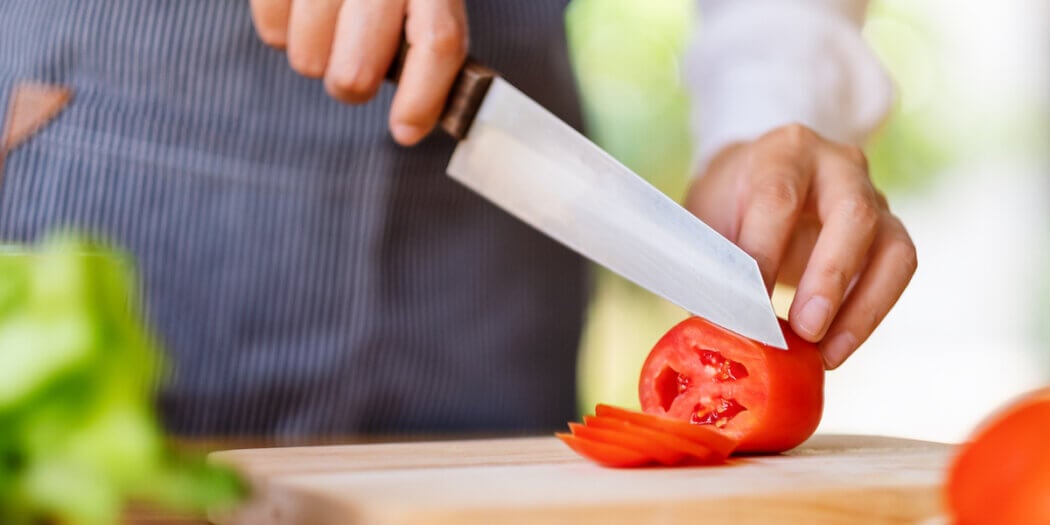
Having a handy-dandy collection of kitchen knives is essential for any home or professional kitchen. Whether you’re a beginner or advanced, here is everything you need to know about basic knife skills.
Knife skill #1: How to hold a knife
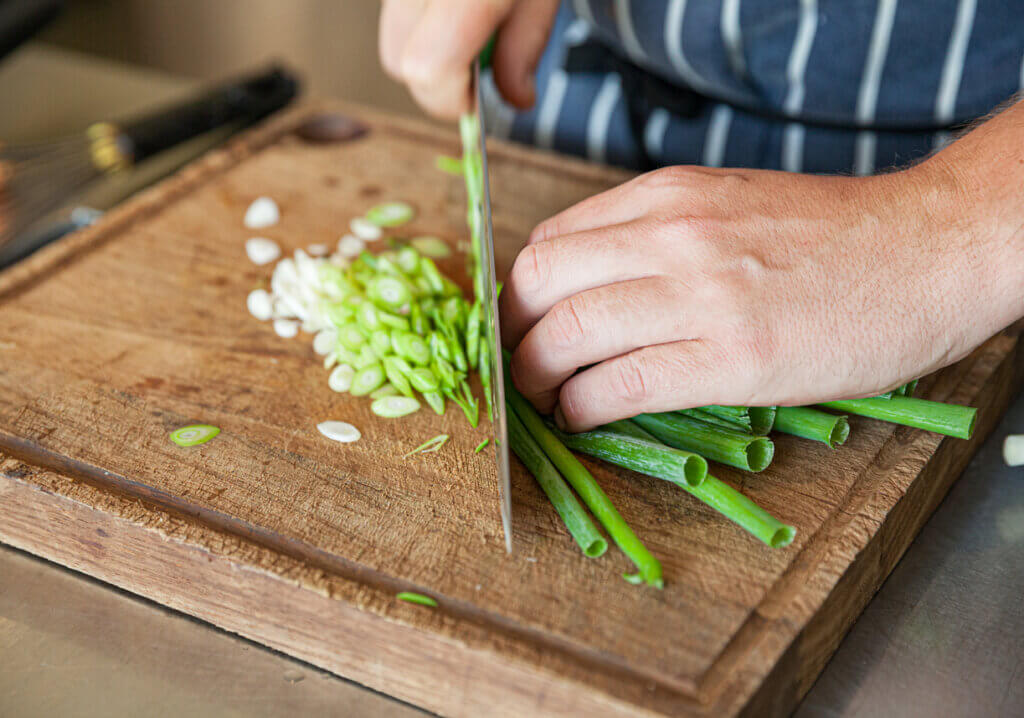
Learning how to properly hold a knife is a foundational knife skill that can significantly help you feel more confident in the kitchen. Both hands play critical roles. The cutting hand is the hand that grips the knife, and the hand stabilizing the ingredient is referenced as the helping hand. The way you utilize both your hands will significantly determine your speed, precision, and safety.
The cutting hand
Inexperienced home cooks may wrap their whole hand around the handle of a knife. However, professional chefs hold knives differently. Professional chefs will usually place their palm high on the handle, close to the blade, while their thumb and index finger grip the top of the blade. Holding a knife this way is the most efficient knife skill method because it utilizes the weight of the knife, the sharpness of the blade, and a person’s arm strength to make the most precise cuts.
The helping hand
The helping hand supports the cutting hand by holding the ingredient being cut. Although the helping hand may not directly touch the knife, it is crucial because it helps stabilize, turn, and grip the ingredient.
The proper way to hold the ingredient is to curl your fingers. By leaving your fingers fully exposed, you could potentially cut your fingertips. When using this technique—often called the claw grip—you curl your fingers slightly so your knuckles are close to the blade. Use your knuckles as a guide for the blade, and then rock your blade over the food to make more precise cuts. If you are not used to this technique, it may feel awkward and uncomfortable at first. However, with practice, using the claw grip will allow you to cut faster and be safer in the kitchen.
Knife skill #2: Identifying different types of knives
While all knives cut food, not all of them cut ingredients the same way. Here are the most basic types of knives to have in your kitchen and the best ways to utilize them.
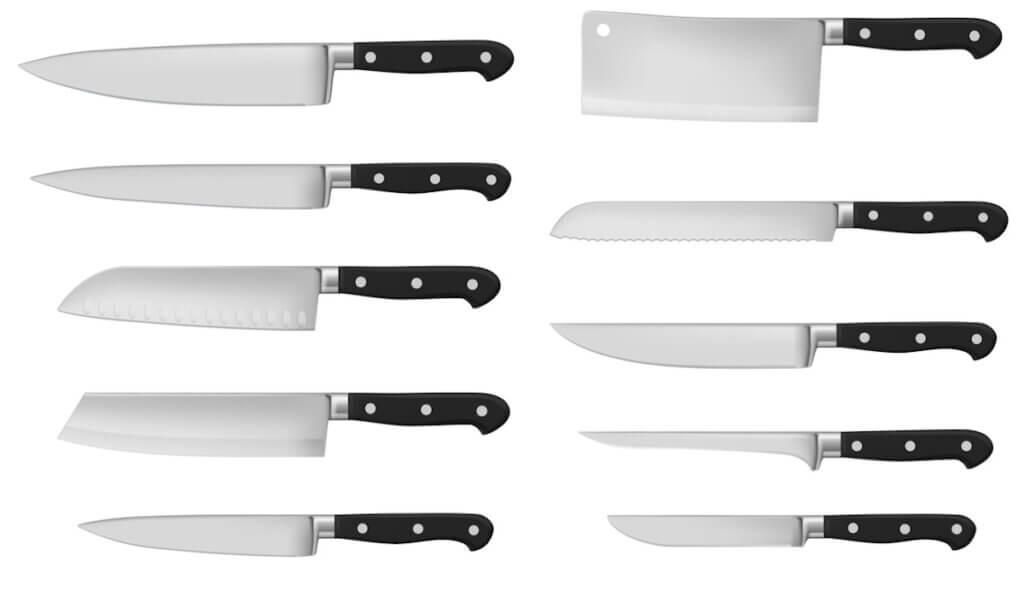
Chef’s knife
One of the most important essential knives you need in the kitchen is a chef’s knife. The blade of a chef’s knife typically ranges from six to ten inches in length. The standard size is usually eight inches. The blade is wide at the point nearest the handle and tapers to a smaller width as you get to the tip. A chef’s knife is primarily used for chopping ingredients; however, it can be used for almost anything. Shop chef’s knives.
Paring knife
A paring knife is smaller in size but used for various tasks in the kitchen. The blade ranges from two to four inches in length. Typically, a paring knife is used for more delicate tasks where a chef’s knife would be too large. There are four different styles of paring knife blades: curved, spear, sharp, and clip point. Shop paring knives.
Serrated knife
A serrated knife will often have a large, slender blade; a ten-inch blade is most common. You can immediately recognize a serrated knife by the ridges on the blade. Serrated knives have a toothed or saw-like edge and are used in a back and forth motion to “saw” through food. Because of their ridged blade, serrated knives are great for items that are soft, have hard rinds, or can be crushed when cutting downwards. Use serrated knives when cutting softer foods like bread, tomatoes, and cooked meat, or use them to cut tougher items like butternut squash, pineapple, or watermelon. Shop serrated knives.
Utility knife
Utility knives are longer in length than a paring knife but shorter in length than a chef’s knife. Utility knives can have standard straight edge blades or can have a serrated blade. A utility knife’s blade is generally around four to seven inches and is great for slicing meat, buns, and sandwiches. Shop utility knives.
Grab it now on Instacart:
Knife skill #3: Learning basic knife cuts
Just like there are essential knives, there are essential knife cuts you should know when cooking in the kitchen. Here are just a few of the different terminology used to describe basic knife cuts.
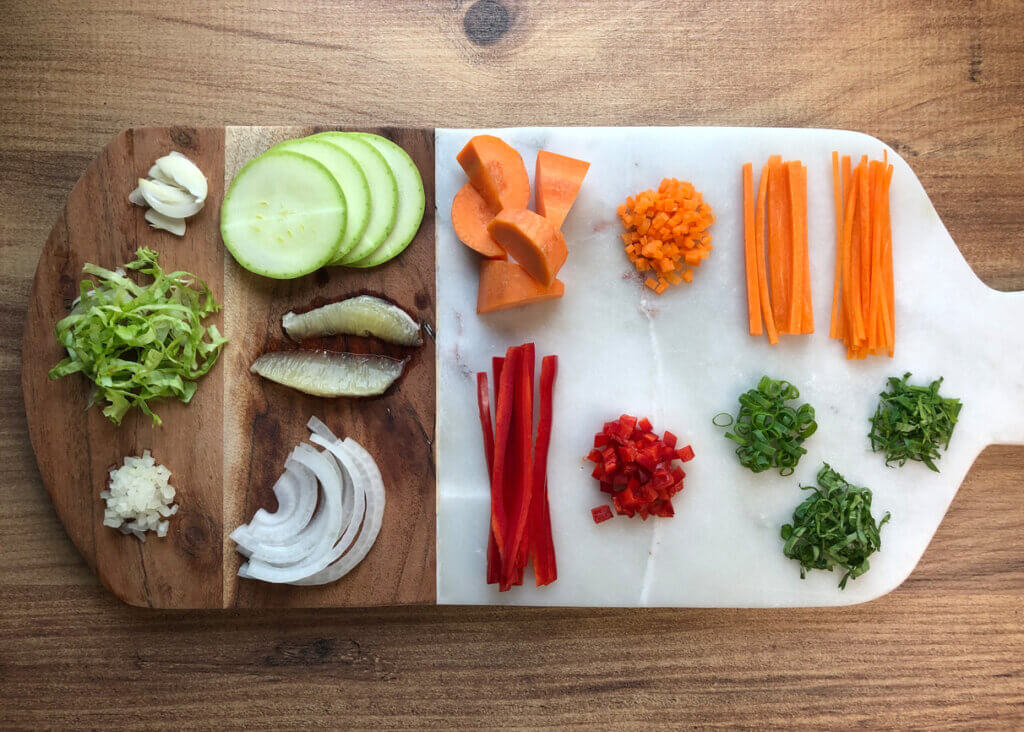
Dice
When a recipe calls an ingredient to be diced, it is typically referring to cutting your item into small squares or cubes. You can utilize a large dice, medium dice, or small dice when chopping your ingredients. All of them will differ in size:
- Large dice: Approximately ¾ inch x ¾ inch x ¾ inch
- Medium dice: Approximately ½ inch x ½ inch x ½ inch
- Small dice: Approximately ¼ inch x ¼ inch x ¼ inch
Julienne
The julienne knife cut is a traditional French technique. To julienne, an ingredient means to cut it into thin strips. The size you should aim for when using this technique is two to three inches in length and around 1/16 to 1/8 of an inch in thickness. You’ll often see vegetables julienned because they marinate or cook quickly. They are also often used to add texture to a dish.
Brunoise
The brunoise cut is the finest sized dice; however, to properly use this technique, you must first julienne your ingredient. To properly brunoise, grab your julienned ingredient and begin to dice them into 3 millimeter (or 0.12 inch) cubes. This technique is properly used when creating garnishes or base ingredients for sauces.
Mince
To mince an ingredient means to cut it into very fine pieces. Minced ingredients are the smallest size you can get without cutting it into a pulp or a puree. Items like garlic and other aromatics are frequently minced and used to disperse flavor throughout the entire dish.
Chiffonade
Smaller leafy greens and herbs like mint or basil are commonly used for the chiffonade knife technique. To chiffonade, tightly roll your herbs from the side and then slice. You should be left with thin ribbons about one to two inches in length and approximately 1/8 inch x 1/8 inch in thickness.
Shop for knives
When it comes to the kitchen, knowing how to hold a knife, understanding the different types of knives, and how to perform basic knife cuts are all essential (and highly beneficial) knife skills. If you would like to add kitchen knives to your collection of standard kitchen equipment, there are many different options you can choose from. To save time, you can search for kitchen knives online via Instacart. Add your preferred knives to your cart and select whether you’d like to pick your items up curbside or have them conveniently delivered to your home. Shop knife set.
Most Recent in Planning & Prep

Planning & Prep
Average Grocery Cost per Month: The 2025 Breakdown
The average grocery cost per month, per person, in the United States is roughly $350 for adults between 19 and 50 years old in a four-person household. This estimation depends on multiple factors, such as…
Dec 23, 2024
Planning & Prep
33 Shocking Global and National Food Waste Statistics (2025)
Did you know nearly 30% of the food produced globally is never eaten? This staggering food waste statistic highlights the alarming issue of uneaten food — a problem with environmental, economic and social consequences. Food…
Dec 23, 2024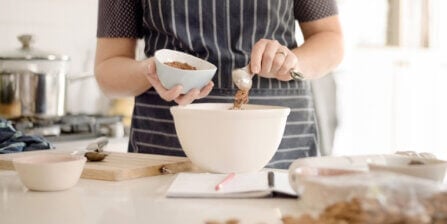
Planning & Prep
12 Best Substitutes for Eggs in Baking
Ever run out of eggs mid-recipe or need a quick swap for dietary reasons? Don’t let an empty egg carton or a food sensitivity stop you from enjoying delicious baked treats! There are tons of…
Dec 19, 2024
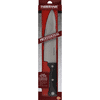
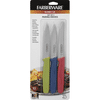




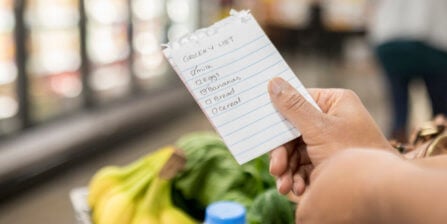 17 Grocery List Categories to Make Shopping Easy
17 Grocery List Categories to Make Shopping Easy 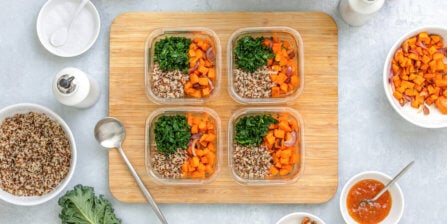 How to Meal Plan: Step-by-Step Guide to Meal Planning
How to Meal Plan: Step-by-Step Guide to Meal Planning  How To Read Food Labels: Guide to Nutrition Labels
How To Read Food Labels: Guide to Nutrition Labels 

